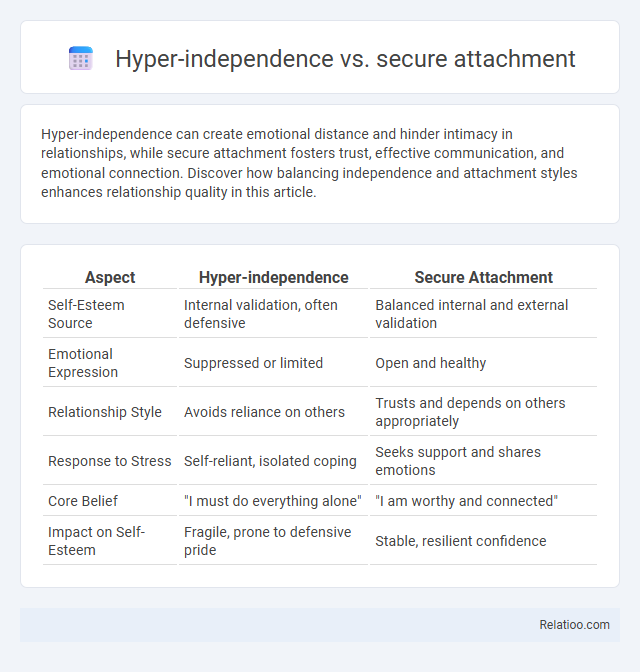Hyper-independence can create emotional distance and hinder intimacy in relationships, while secure attachment fosters trust, effective communication, and emotional connection. Discover how balancing independence and attachment styles enhances relationship quality in this article.
Table of Comparison
| Aspect | Hyper-independence | Secure Attachment |
|---|---|---|
| Self-Esteem Source | Internal validation, often defensive | Balanced internal and external validation |
| Emotional Expression | Suppressed or limited | Open and healthy |
| Relationship Style | Avoids reliance on others | Trusts and depends on others appropriately |
| Response to Stress | Self-reliant, isolated coping | Seeks support and shares emotions |
| Core Belief | "I must do everything alone" | "I am worthy and connected" |
| Impact on Self-Esteem | Fragile, prone to defensive pride | Stable, resilient confidence |
Understanding Hyper-Independence: Definition and Origins
Hyper-independence is characterized by an excessive reliance on self-sufficiency, often stemming from early attachment disruptions or emotional neglect, contrasting with secure attachment which promotes healthy interdependence and emotional regulation. This coping mechanism serves as a defense against vulnerability, leading individuals to avoid seeking support or forming close emotional bonds. Understanding the origins of hyper-independence involves examining developmental experiences where trust and safety in relationships were undermined, resulting in patterns of emotional self-reliance and detachment.
What Is Secure Attachment? Key Traits and Benefits
Secure attachment is characterized by trust, effective communication, and emotional balance in relationships, providing a stable foundation for personal growth and well-being. Key traits include comfort with intimacy, healthy boundaries, and resilience to stress, which foster deeper connections and mutual support. Your ability to form secure attachments enhances emotional regulation and promotes long-term relationship satisfaction.
Childhood Influences: Roots of Hyper-Independence vs Secure Attachment
Childhood influences play a crucial role in shaping hyper-independence and secure attachment, where hyper-independence often stems from inconsistent caregiving or emotional neglect, prompting children to rely solely on themselves for safety and validation. Secure attachment arises from responsive and nurturing caregiving, fostering trust and healthy interpersonal connections that support emotional regulation and resilience. Understanding these roots highlights how early relational experiences distinctly impact emotional development and interpersonal dynamics in adulthood.
Emotional Impact: Hyper-Independence vs Secure Attachment in Relationships
Hyper-independence often leads to emotional isolation and difficulty in forming deep connections due to a fear of vulnerability, resulting in strained relationships and unmet emotional needs. Secure attachment fosters emotional intimacy and trust, enabling individuals to communicate openly and support each other through challenges, promoting relational satisfaction and stability. The emotional impact of hyper-independence contrasts with secure attachment by creating barriers to closeness, whereas secure attachment encourages healthy dependency and resilience in relationships.
Communication Styles: Differences Between Hyper-Independent and Securely Attached Individuals
Securely attached individuals exhibit open, clear, and empathetic communication, fostering trust and emotional connection, while hyper-independent individuals tend to communicate with guardedness, minimizing vulnerability and often avoiding emotional disclosures. The communication style of securely attached people encourages collaboration and mutual support, contrasting with hyper-independent individuals who prioritize self-reliance and may struggle to seek help or express needs. These differences impact relationship dynamics, as secure attachment promotes intimacy, whereas hyper-independence can lead to emotional distance and misunderstandings.
Trust and Vulnerability: How Attachment Styles Shape Connection
Trust and vulnerability are crucially shaped by your attachment style, with secure attachment fostering open communication and genuine emotional safety. Hyper-independence often results in guarded behavior that limits trust and discourages vulnerability, creating barriers to deep connection. Understanding these dynamics can help you navigate relationships by balancing autonomy with emotional openness.
Signs You May Be Hyper-Independent or Securely Attached
Signs You may be hyper-independent include avoiding help from others, difficulty trusting, and reluctance to express vulnerability, often stemming from past emotional wounds and a strong desire for self-reliance. In contrast, secure attachment is characterized by healthy communication, comfort in seeking support, and balanced emotional intimacy, reflecting confidence in relationships and self-worth. Your ability to recognize these signs helps promote emotional well-being and improve connection with others.
Breaking the Cycle: Moving from Hyper-Independence to Secure Attachment
Breaking the cycle from hyper-independence to secure attachment involves recognizing and addressing the fear of relying on others while fostering trust and emotional vulnerability in relationships. You can cultivate secure attachment by practicing open communication, setting healthy boundaries, and seeking support without guilt or hesitation. Developing this balance promotes emotional resilience and deeper, more fulfilling connections with others.
Mental Health Implications of Hyper-Independence and Secure Attachment
Hyper-independence often leads to increased stress, social isolation, and difficulty seeking support, negatively impacting mental health by fostering anxiety and depression. Secure attachment promotes emotional resilience, healthy relationships, and effective coping strategies, supporting overall psychological well-being. Understanding these dynamics highlights the importance of balanced independence intertwined with secure relational bonds for optimal mental health outcomes.
Building Healthy Relationships: Cultivating Secure Attachment
Building healthy relationships requires understanding the balance between hyper-independence and secure attachment, where secure attachment fosters trust, emotional openness, and mutual support. Unlike hyper-independence, which often leads to emotional isolation and difficulty relying on others, secure attachment encourages vulnerability and connectedness, essential for long-term relationship satisfaction. You can cultivate secure attachment by practicing consistent communication, empathy, and emotional responsiveness in your interactions.

Infographic: Hyper-independence vs Secure attachment
 relatioo.com
relatioo.com